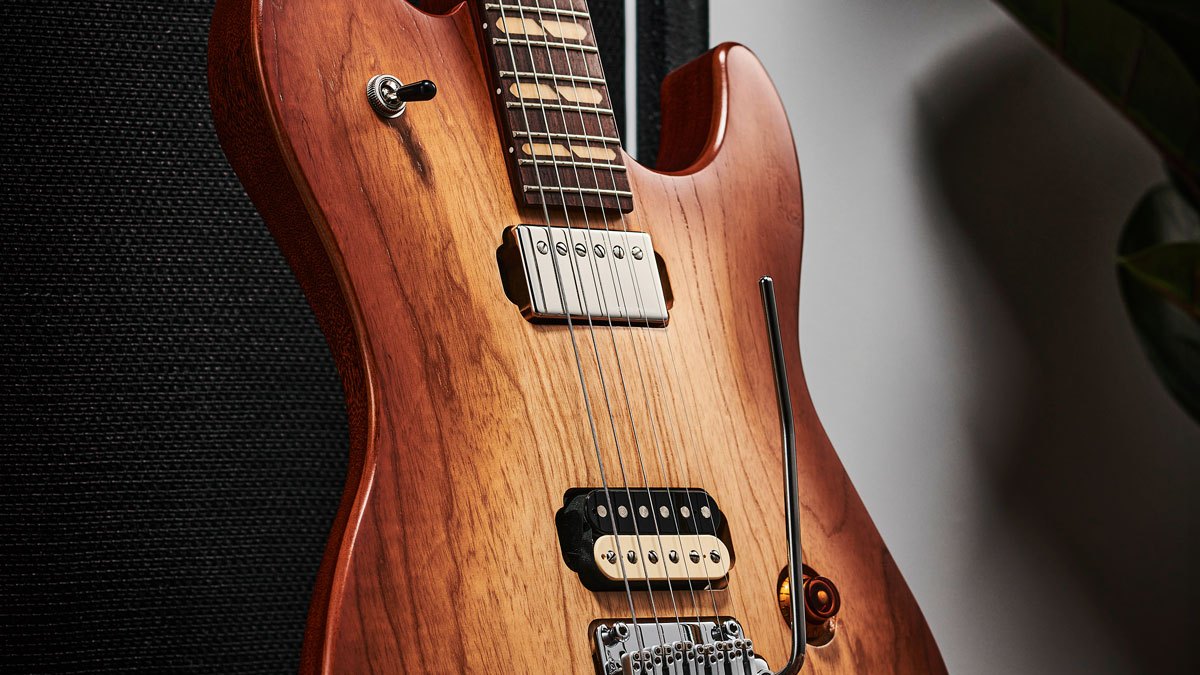Guitar World Verdict
This Radium-X’s unshowy, quite classic dress hides some superb sounds along with plenty of choice in how you use them. It’s a thoughtful design, and straight out of its gigbag is a really good player that’s also light in weight.
Pros
- +
Classic, classy chambered-body build.
- +
Good weight, neck profile, playability.
- +
Good sounds – both magnetic and piezo 'acoustic'.
Cons
- -
Be good to see a better gigbag at this price.
- -
Colour choice could be expanded.
You can trust Guitar World
It’s been a while since we reviewed a Godin electric guitar – actually just over two years. And you don’t need us to tell you that quite a lot has happened since then.
World events, factory shutdowns and the rising price of raw materials, parts and shipping have all played their part. So you have to doff your cap because if Godin is to retain – or, perhaps more accurately, regain – some market share, then this new Radium-X is quite a statement of intent.
Multi-voice, innovative guitars have been a cornerstone of Godin’s output over recent decades: instruments built with purpose in mind. The Radium-X falls bang into that category with its blend of pickups – standard magnetic with less-standard piezo – creating a ‘hybrid’ electric-plus-acoustic platform. But before we get there, there’s plenty going on with the instrument itself.
The body shape here has already been used on the standard Radium and Stadium models, a Telecaster-inspired outline with a pulled out bass-side shoulder and slightly thinner treble-side horn. The back is mahogany, two-piece centre-joined, and by tapping our fingernails around the body it sounds like it’s fairly extensively chambered on the lower bass side of the body, behind the vibrato rout, and quite extensively on the treble side, too.
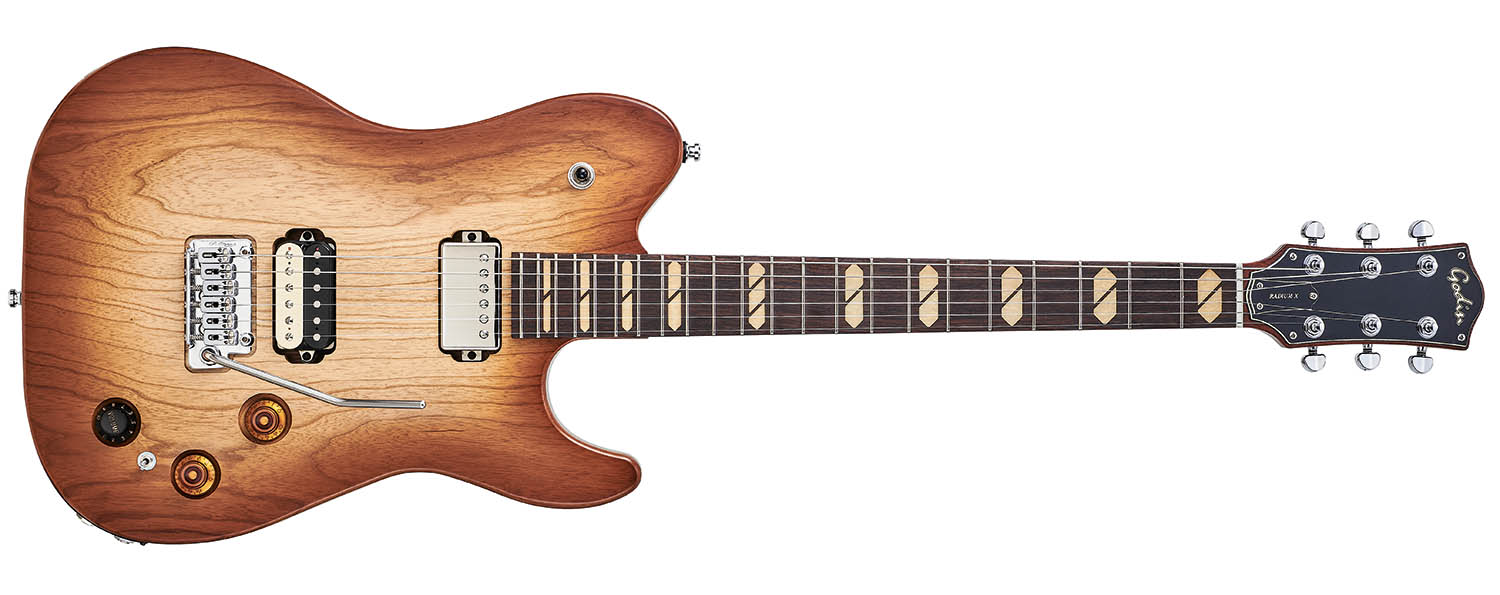
That hollowed structure, around 36mm deep, is topped with a 15mm thick one-piece swamp ash top that has a shallow violin-like carve, giving an overall depth of 51.6mm and a rim depth of approximately 40mm. Outwardly, the back is carved, too, with a deep ribcage contour that flows into smaller chamfering around the back’s edges.
The heel is left pretty square but somehow suits the rather classic style: the deep red stain to the mahogany recalls the craft of the jazz-era archtop, as do those nicotine-stained two-piece inlays, which also feature on a trio of new Godin 5th Avenue Jumbo models, the Montreal Premiere Limited and the solidbody Summit Classic.
This evocative vibe continues with the mahogany neck, which has a head-splice around the position of the two lower tuning machines, but you really have to look closely to spot it. That very classic three-a-side headstock is dead classy, although here it’s faced with a black/white/black plastic laminate, giving echoes of Godin’s Radiator. We’ve previously criticised Godin for its proliferation of brand logos on the one guitar, but not here. There’s just the engraved headstock logo, that’s it.

Our review model is finished in Rustic Burst ‘semi gloss’, but it’s super smooth to the touch and very thin, which allows you to feel the grain lines in the ash top. Overall, it’s one of the smartest builds we’ve ever seen from Godin.
Now, if Godin had simply loaded in a couple of decent humbuckers with some basic switching you’d still have quite a guitar. But there’s much more going on here, the centre of which is the well-respected LR Baggs X-Bridge, a two-post vibrato with individual piezo elements mounted within the block saddles. Typically well designed and made, it also features a push-in-and-screw tension-adjustable arm and sits in a lightly recessed rout.
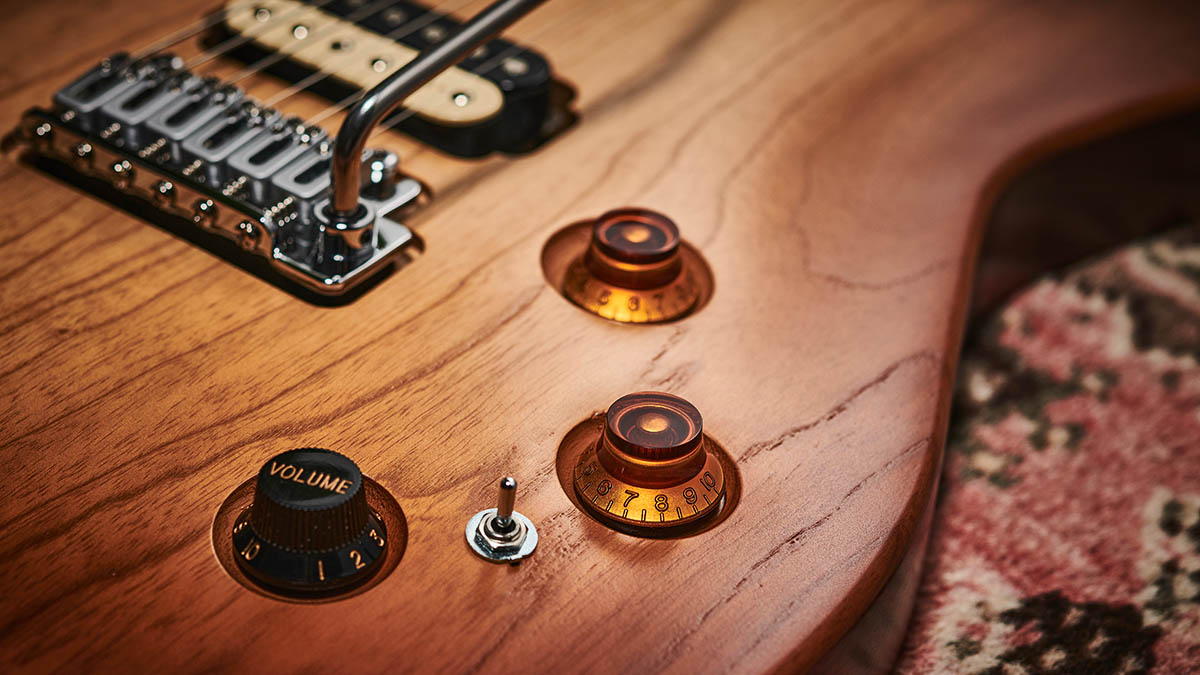
Both magnetic pickups mount to the body with a little height adjustment: a Bare Knuckle Boot Camp True Grit at the bridge, uncovered with zebra coils, while a covered Seymour Duncan Jazz gets the neck position.
The upper shoulder-placed toggle selects the magnetic pickups as usual, then we get a master volume and tone that sit in recessed divots. Likewise, the X-Bridge’s volume/blend control, which is the lower Strat-like black knob (although another amber top hat is provided in the gigbag if you want a more matched appearance).
The small three-position mini-toggle switch gives us piezo only (down), magnetic only (up), and both systems together (middle). You can run the magnetic and piezo into two separate amps via the two output jacks, or use the jack closest to the strap button for a mixed mono output into one amp.
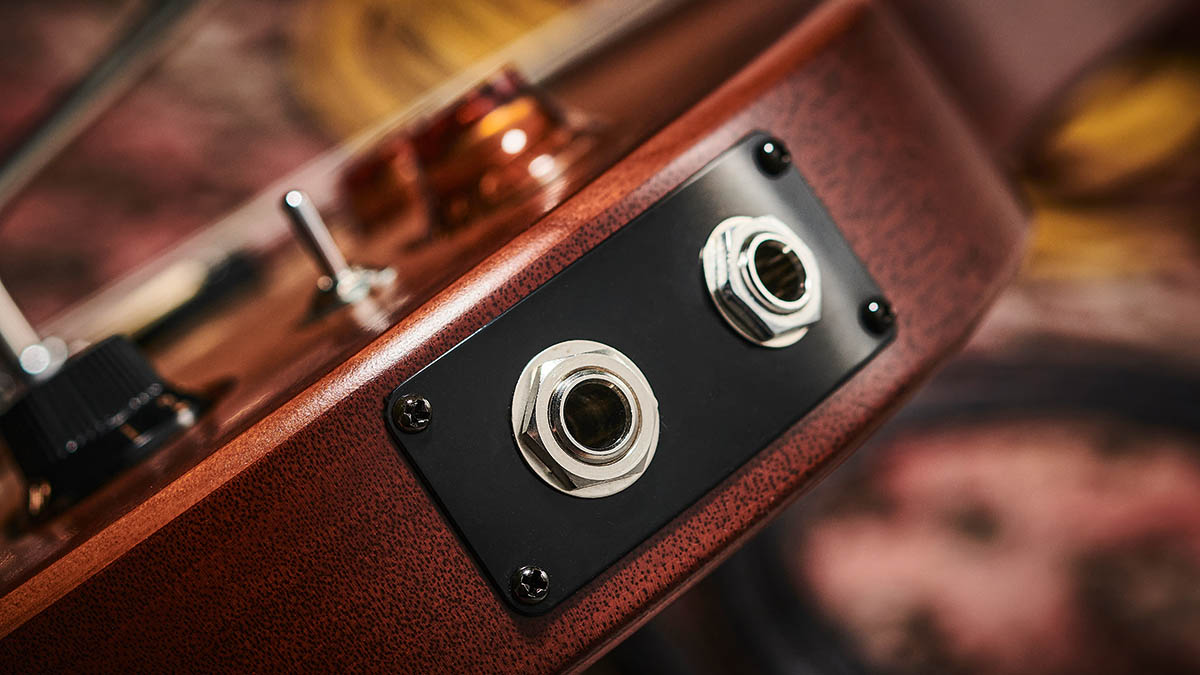
Feel & Sounds
First off, the pretty light weight of 3.39kg (7.46lb) is very engaging, as is the neck profile, which is Fender-y in width (42.4mm at the nut, 51.8mm by the 12th) with a subtly V’d back shape that actually feels a little deeper than it measures (21.2mm at the 1st fret, 23.6mm at the 12th).
The fingerboard sides are incurving and the top edges are lightly rolled, and on the 305mm (12-inch) face the medium jumbo wire (2.42 by 1.2mm) is a good choice. It’s well set up, too, especially considering that it shipped directly from Canada to Guitarist HQ.
There’s virtually zero relief and an airy action height of 1.5mm on the treble side, 1.7mm on the bass side. You really get the impression that someone has put some time and care into this setup: it plays very well and, unplugged, there’s a lively response. The guitar feels very alive.

Starting with the magnetic voices, the Jazz at the neck is a near-perfect choice with its classic output, not over-thick and with a clarity that may well be pared back by the instrument’s construction. It cleans up really well with some volume reduction, thinning the sound and becoming a little more single-coil-like, but back on full throttle it’s beautifully vocal and Gibson-esque.
The medium-output True Grit again seems slightly pulled back in terms of its high-end response, resulting in quite a mid-forward kick that seems aimed at the hotter side of classic blues and rock, and through a cranked gain-y amp sounds seriously thick yet still pretty articulate. It’s a shame there’s no coil-split here, but volume reduction is your friend if you want a little more cut and to reduce the heft.
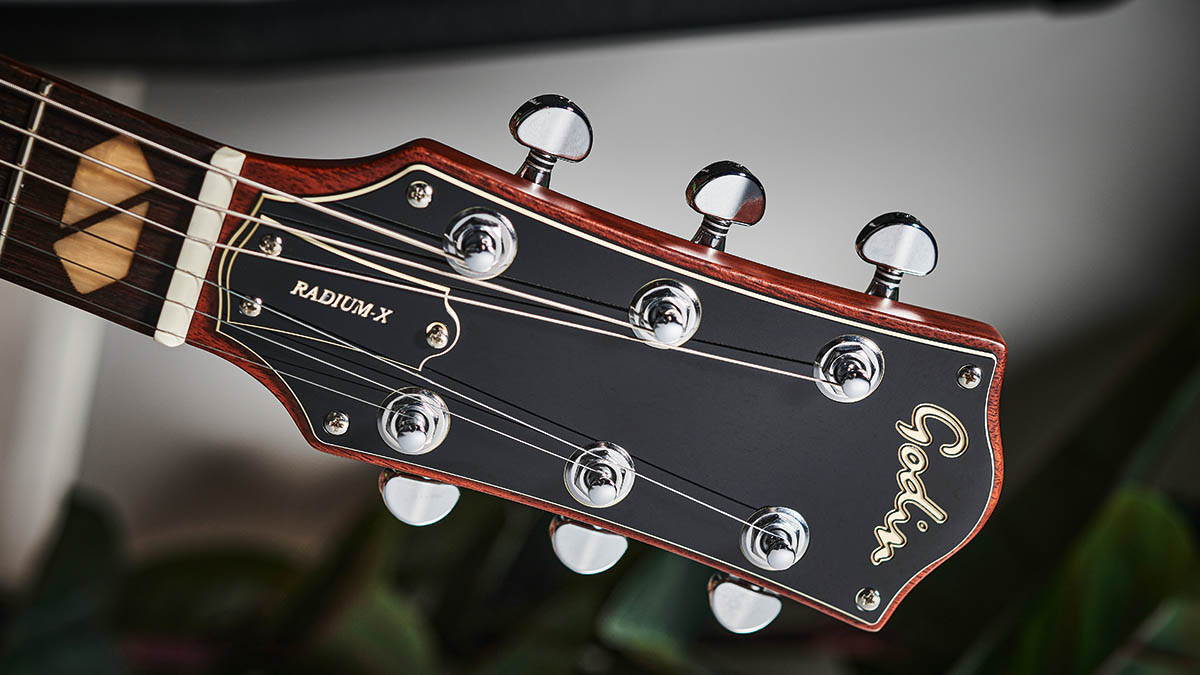
Switching to piezo mode, still from the mixed mono output, that lower piezo blend control doesn’t function and the magnetic volume becomes your master, the tone just pulling back some high treble right at the end of its travel. In ‘both-on’ mode the black knobbed control now acts as a blend for the piezo, while the magnetic volume and tone also act as master controls.
Using the separate outputs to two separate amps things change again. The gold knobs act on the mags and the black becomes a volume for the piezo. There’s no master volume now, so if, for example, you get a nice balance between the two sounds but just want to lower your level, then you need to pull back both volumes.
Nevertheless, the actual piezo ‘acoustic’ voice is good. It’s not going to fool anyone that you’re playing a nicely mic’d Martin, but the acoustic-like brightness and zing can certainly cover acoustic intros and the like in those tricky cover-band sets. And going mixed mono into an AER, aside from adding to the acoustic guitar illusion, you’ve got your jazz gigs covered where the piezo can add just a little clarity to that neck humbucker.
Verdict
While the modern ‘hybrid’ electric with acoustic sounds goes back to the early ’90s, it remains a hugely valid tool for the right player needing to cover both bases, or the creative musician looking for new hybrid sounds by combining the two.
This Radium-X’s unshowy, quite classic dress hides some superb sounds along with plenty of choice in how you use them. It’s a thoughtful design, and straight out of its gigbag is a really good player that’s also light in weight.
Okay, it’s not a cheap date or impulse purchase, but so long as Godin can keep its pricing in check, consider the brand back in the game. A welcome return.
Specs
- PRICE: $2,250 / £2,699 (inc gigbag)
- ORIGIN: Canada
- TYPE: Double-cut, solidbody electric
- BODY: Chambered mahogany back with carved swamp ash top
- NECK: Mahogany, glued-in
- SCALE LENGTH: 648mm (25.5”)
- NUT/WIDTH: Graph Tech Tusq/42.4mm
- FINGERBOARD: Rosewood, pearloid inlays, 305mm (12”) radius
- FRETS: 22, medium
- HARDWARE: LR Baggs X-Bridge (with locking plate), Godin rear-lock tuners – nickel/chrome-plated
- STRING SPACING/BRIDGE: 52mm
- ELECTRICS: Nickel-covered Seymour Duncan Jazz SH-2 humbucker (neck), zebra-coiled Bare Knuckle Boot Camp True Grit humbucker (bridge), LR-Baggs piezo bridge. 3-way toggle (magnetic pickup selection), 3-way mini-toggle mode switch (magnetic/both/piezo), magnetic volume and tone, piezo volume. Separate magnetic and piezo outputs or mixed mono output
- WEIGHT (kg/lb): 3.39/7.46
- LEFT-HANDERS: No
- FINISHES: Semi Gloss Rustic Burst (as reviewed), Natural
- CONTACT: Godin

Dave Burrluck is one of the world’s most experienced guitar journalists, who started writing back in the '80s for International Musician and Recording World, co-founded The Guitar Magazine and has been the Gear Reviews Editor of Guitarist magazine for the past two decades. Along the way, Dave has been the sole author of The PRS Guitar Book and The Player's Guide to Guitar Maintenance as well as contributing to numerous other books on the electric guitar. Dave is an active gigging and recording musician and still finds time to make, repair and mod guitars, not least for Guitarist’s The Mod Squad.
“This would make for the perfect first guitar for any style of player whether they’re trying to imitate John Mayer or John Petrucci”: Mooer MSC10 Pro review
“The most in-demand mods straight from the factory”: Fender’s elevated Player II Modified line brings the firm’s most sought-after guitar upgrades to the masses
